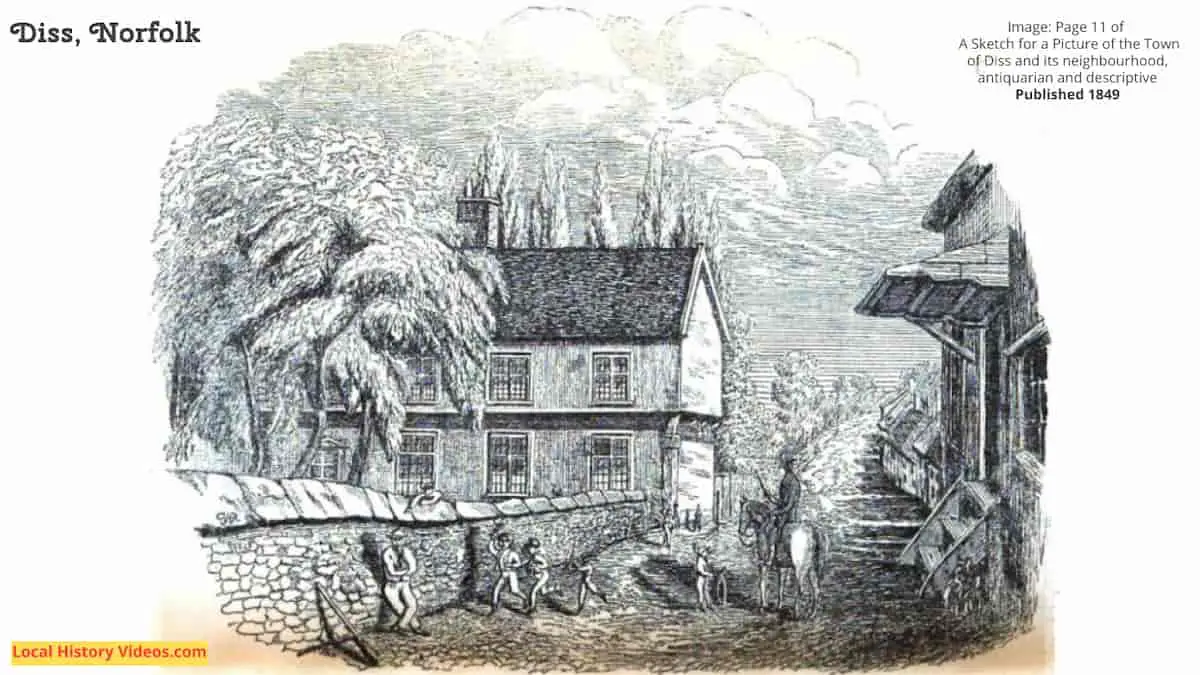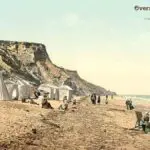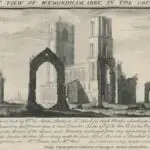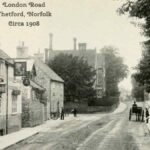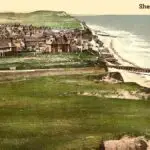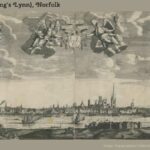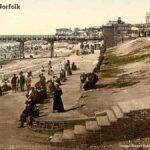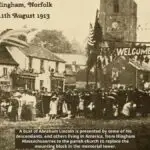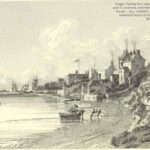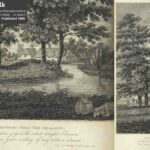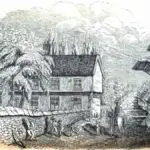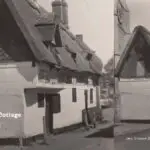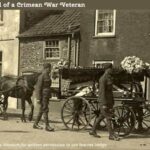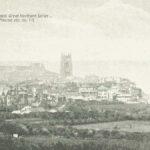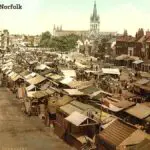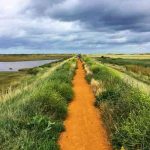Glimpse history through old images of Diss, Norfolk, England.
Duck Auction (1934)
About a minute into this short footage, we see horses and carts arriving at a market where 6,000 ducks held in cages are auctioned off in one day.
Then we see a group of men, some of them smoking, as they pluck feathers out of dead ducks at a poultry processing site.
Ducks And Duckies From Diss (1934) – British Pathé on YouTube
Lamb Auction (1934)
Footage shows a large flock of sheep being herded on foot to the market pens.
Sheep coming from the farms further afield arrive by train and lorry.
As the auctioneer gets down to the businesses of selling 12,000 lambs in one day, you can see some of the nearby houses in the background.
Bidding For Baa-Baas (1934) – British Pathé on YouTube
Steam Engines (1963)
Alan Bloom, Vice Chairman of the Norfolk Steam Engine Society, has restored elevent old agricultural steam engines. He’s shown with a little girl who is presumably his granddaughter.
Steam Engine Collection (1963) – British Pathé on YouTube
A bit of Diss history
Extract from: A Sketch for a Picture of the Town of Diss and its neighbourhood, antiquarian and descriptive
Published in 1849
Pages 3 -16
It is a remarkable point of his journey the traveller has reached, just here. He is on the borders of the two great agricultural counties – nearly at equal distance from Norwich, the metropolis of East Anglia, from the ancient and once important city of Thetford, from Ipswich and Bury St. Edmund’s, the rival county towns of Suffolk, from Framlingham, the fortress of the Bigods, and from their vaunted
“ castle of Bungay
Upon the river of Waveney. “
Thus central, yet some two miles distant from Scole Inn – that noble old house, whose name indicates a similar commanding position on the now forsaken turnpike road is the hitherto secluded but flourishing and pleasant town of DISS.
If business or other engagements be not imperative, it may be worth while to spend a day here, or at least to wait for the next train, and ramble into this pretty place. Will the stranger allow us to offer our humble services ? –
The Approach to the town, then, be it observed, -this spacious road, now gradually assuming the appearance of a broad suburban street, was wisely formed about five and thirty years ago, when the commons were inclosed, and when as yet the idea that it would ever be crossed by a railway arch had never entered the mind of the sagest inhabitant.
On the right are the Almshouses, a building formerly used as a workhouse, but adapted and appropriated to its present purpose on the erection of the union house at Pulham.
Thither is said to have been carried the ‘ sanctus ‘ bell which for ages had occupied in succession the turret over the parish church and the cupola upon the workhouse, and had in turn called the Catholic population to their devotions and poor Protestants to their meals.
The Rectory next presents itself, retiring albeit amidst agreeable plantations; a large portion of which have grown up in the time of the present venerable and justly respected incumbent, the rev. William Manning.
Leaving, on the same side, the Wesleyans ‘ Chapel and their Sunday School Rooms, with the single remark that the followers of Wesley have been numerous, useful, and of good repute here for many years; and turning northward, the visitor would find his eye resting on the Independents ‘ Chapel, of gothic design and somewhat more ostentatious mien, but the attention is instantly arrested by The Mere, a sheet, or rather a basin, of water nearly twenty feet in depth.
From it the town derives its ( Anglo Saxon ) name; hence, too, a shield wavy was adopted as the device upon the Diss Farthing, coined in defiance and proclamations of laws during the scarcity of small change in the reign of Charles II; and which device, duly modified and embellished, has been since employed to decorate certain paper symbols of greater conventional value.
The mere is of considerable depth, abounding in roach and eels, and is surrounded by sloping gardens, save where there is a public watering place, and except also that on the south the scene is varied by the Park Field, whose cool green turf, skirting the water’s edge, invites the weary footstep, and towards which the stately swan glides majestically across the smooth lake.
Through the trees is seen the Unitarian Chapel, of simple but not inelegant design, built here to succeed the old Presbyterian meeting – house at Palgrave, wherein the late recorder Alderson, father of the baron, was ordained ‘ in the year 1775, together with Mr. Barbauld, husband of the authoress, ( see p. 18. ) forms the principal widens into the Mere Street entrance of the town; but very soon Market Place, from whence the other principal streets diverge without either intricacy or formality.
The very first house on entering the market – the house occupied by Mr.Abbott, printer has one of those curious signs of antiquity, a carved angle post.
The market, ‘ says a modern topographical work, is kept weekly on Friday, the chief of which consists of the linen cloth manufacture. ‘ But the latter part of this description properly relates to a period long gone by.
The hemp cloth traffic was partly conducted in the square near the public pump, and though it declined many years ago, the hook on which the town scales were suspended was to be seen not very long since in the ceiling of the portico to a draper’s shop there.
The cloth sales always began at seven in the morning throughout the year.
Another important craft here was that of the stay – maker, affording employment to many of the inhabitants.
The stays, of stout leather for the humbler classes, and of whalebone, canvass, and jean for ladies, were almost equally pistol proof and rigid, and are, happily, well nigh obsolete.
A similar falling off has attended the woolstaplers and wool combers, in which some opulent families were engaged.
Masters and men were wont to celebrate St. Blaze’s Day with a grand pageant. This was last observed in Diss in 1801.
At present the principal article of merchandize is corn, invariably sold by sample.
Formerly, when this was a ‘ pitched ‘ market, the corn left unsold on a market day was deposited in a large upper room in the toll house.
A door, very near to the lock – up for petty offenders, opening upon a solid oak staircase, leads to this room.
In the same house it is still customary to open the court of the Lord of the Manor of Diss with the Members, and in another part of it are deposited the stalls, scales, halberds and paraphernalia.
On the evenings of the two annual Fairs, one held in the market place in September, and the other on Cockstreet green in November, the bailiff of the lord of the manor calls upon divers householders and requests them to take a halberd, ‘ a duty which by some is willingly commuted for a small douceur, while others, like the clowns of the chamberlain of Loch Leven, bating their party coloured ribbons, march round the fair and take their stations as guardians of the night.
On the day preceding the September fair ( or sessions ‘ ) – a singular custom prevails here, among the lower classes, of chalking each other, the origin of which is unknown, and which may have been substituted for the festival of Holy Cross Day, or some like ceremony abolished at the reformation.
The toll house above mentioned and some other buildings interfere with the commanding view which is still attainable, in certain directions, of the Parish Church.
This edifice is chiefly remarkable for its upper or cleristory windows. Above the junction of the nave and chancel will be observed the bell – turret already mentioned. The tower, strongly buttressed, has a transverse archway serving as a porch or galilee, a peal of most musical bells, and those scarcely less cheerful appendages, a clock and chimes. The interior presents nothing very remarkable, except the piscina, lately exposed, having been shorn of very many of the peculiar features of antiquity. The north and south aisles terminate towards the east in what were formerly chapels belonging to the guilds of Corpus Christi and St. Nicholas.
There are, of course, many monumental inscriptions, both within and without, in which occur the names of Sheriffe, an active but prudent royalist in the troublous Cromwellian era – Coggeshall, inventor of the guaging rule known by his name – Wiseman, a writer in the Philosophical Transactions – Kidman, who introduced the reading of Locke at Cambridge Belward, of Caius College – and others.
Diss Church is associated with the memory of the merry poet laureate Skelton – the tutor of Henry VIII and rector of Diss. But there are no remains of the rood loft mentioned in Skelton’s singular poem Ware the Hawke, ‘ wherein he severely censures the fond frantyke fauconer ‘ who allowed his passion for hawking to get the
better of his sense of propriety, and rudely
* Said that he would hunt
From the auter to the funt. ‘
Within the last thirty years the burial ground has been repeatedly enlarged.
First, by appropriating the south part of the broad path which had surrounded it, and which may possibly have been adapted to some processions or ceremonies of the Romish Church, such as the choice of a ” boy – bishop ” on the feast of St. Nicholas.
Then, by the removal of the gloomy almshouses built by Mr. (Can’t read the signature) whose tomb will be found at Roydon.
And, still more recently, by adding the site of the Guildhall premises, once the scene of busy trade and gay festivities, but granted to trustees for the inhabitants, when the reformation aimed to ‘ place the school by the side of the church.
Here, probably, Cleber, ‘ a schoole master sometime at Dys, ‘ who was executed as a traitor for ‘ conspiring to place the lady Elizabeth on the throne, ‘ may have swayed the ferule.
Hither the charity school established at Palgrave in 1711 was soon removed, and here it was carried on until ousted by the grammar school, the last conductor of which was the rev. Simon Westby.
After his death in 1820, the school – room was occupied by a national ‘ girls ‘ school.
The skeleton of the guildhall was probably as old as the reign of Henry VII, and, despite the repairs and improvements ‘ of successive ages, it asserted its antiquity to the last, by the projecting upper story, and by this rude carving on the upper part of a massive oak corner post.
In the autumn of 1846 the building, having been sold by auction, was levelled with the ground; and the spot, oft trodden by anxious traffickers and merry brethren, whereon many a young heart had bounded with delight or sobbed be neath the rod of whole some discipline, was itself added to the ever encroaching territory of death.
The glory of Diss church – yard we always considered to be its double row of shady limes on the north and east. Some of these are still spared, though often threatened with capital punishment for dripping upon the passenger and resisting the spade of the grave – digger.
On the coping of the south wall of the church – yard was, thirty years ago, a stone which, joined with the name of a founder or benefactor had once occupied a place in some ecclesiastical building, the word Orate ‘ having evidently formed a part of the usual formulary on the tombstones of our Roman Catholic forefathers.
That flint wall, since more neatly rebuilt, adjoined what is now known, very properly, as Church Street but was formerly called, not without reason, Dirty Street – reminding one of the medieval description of Norwich’ flynt valles.. dyrt quoque vicus. ‘
It leads by a walk to the rectory, or through a rural lane and across the railway, to Frenze – hall. ( See p. 22. )
Due north from the market place, broad and airy, is Mount Street, in which are some good residences, with very pleasant gardens and grounds tastefully arranged.
At the extremity of this gradual elevation an inviting road leads eastward to Walrat Ball, the residence of the late Thomas Jenkinson Woodward esq. LL.B. known among his neighbours on account of his usefulness and his urbanity, and to the scientific world as a botanist.
The parish of Diss extends northward about four miles, terminating at Beywood Ball, a manor house which has seen better days, and where, in the olden time dwelt sturdy yeomen who found their ‘ height of worldly felicity ‘ in this woody district and upon the long and rough chaseway emphatically yeleped ‘ the Heywood’ just because they found there space and game for the free enjoyment of field sports.
Trees of great age remained in abundance around the house within the last fifty years.
About the beginning of the present century Heywood hall underwent what is called a thorough repair, and then probably it was that the carved panels still existing in an upper room were removed from some more conspicuous position and consigned, like the tombs of the Chinese, to the honors of a periodical whitewashing.
The carvings represent the pastime of duck – hunting, now happily unknown, though it appears to have been much practised, even about London, till after the middle of the last century.
If the courteous reader will accept our illustrations and would rather eschew so long a walk, we would invite him to return to the Church. Thrust in between the western but tresses of the bell tower is a tall tenement long known to the schoolboys of Diss as Mrs. Coble’s shop, ‘ from the name of the occupant, whose pastry and fruit allured so successfully that she lived to a good old age no schoolboy having ever been known to emulate the heroism of Ulysses within sight of her fascinating window.
From this point runs St. Nicholas Street, uniting with the more steep ascent from the market place at the spot where once stood a chapel built about the time of Henry V, by the consolidated guilds of St. Nicholas and Corpus Christi.
It was left to decay in the reign of Edward VI, and its site has long been occupied by dwelling – houses.
Very near is an ancient house, the corner of which retains another very perfect specimen of the carved angle post, quaintly illustrating the birth of Christ and either the purification or some other event in the history of the Virgin.
We have now reached Crown Street, the most spacious in the town, and receiving its name from the Crown Inn.
On a terrace hard by is the house where the celebrated Tom Paine worked for one Gudgeon, a staymaker.
A straggling road – commanding, if we may venture to lift the latch of a door on the left, a pretty view of the mere and town – runs southward to Cark Street.
On this green the fair is held at the feast of Sts. Simon and Jude.
A little further the Waveney, which bounds the parish and the county, is crossed by an arch of modern construction.
The Waveney – said to have been so named, far down in its broader estuary and in a distant age, from wafiend ea, the wavy or troubled water, and described by sir Henry Spelman, with the Ouse, both rising at Lopham five miles off, ( see p. 19. ) as ‘ quarrelsome brothers ‘ – but peaceful enough here – a mere streamlet in which one may pause to watch the nimble turning of the minnow, ‘ or which one may cross without note of its existence.
Until within a few years, as the river was here generally fordable, the bridge was but a wooden structure just sufficient for a bridle – way.
Improvement has been attended, as is very commonly the case, with a sacrifice of the picturesque.
More about Norfolk
- Old Images of Norfolk, England
- Old Images of Wymondham, Norfolk
- Old Images of Thetford, Norfolk
- Old Images of Sheringham, Norfolk
- Old Images of King’s Lynn, Norfolk
- Old Images of Hunstanton, Norfolk
- Old Images of Hingham, Norfolk
- Old Images of Gorleston-on-Sea, Norfolk
- Old Images of Fakenham, Norfolk
- Old Images of Diss, Norfolk
- Old Images of Dereham, Norfolk
- Old Images of Overstrand, Norfolk
- Old Images of Attleborough, Norfolk
- Old Images of Holt in Norfolk
- Old Images of Cromer, Norfolk
- Old Images of Norwich, Norfolk
- Old Images of Great Yarmouth, Norfolk
- Norfolk: Local History Resources

